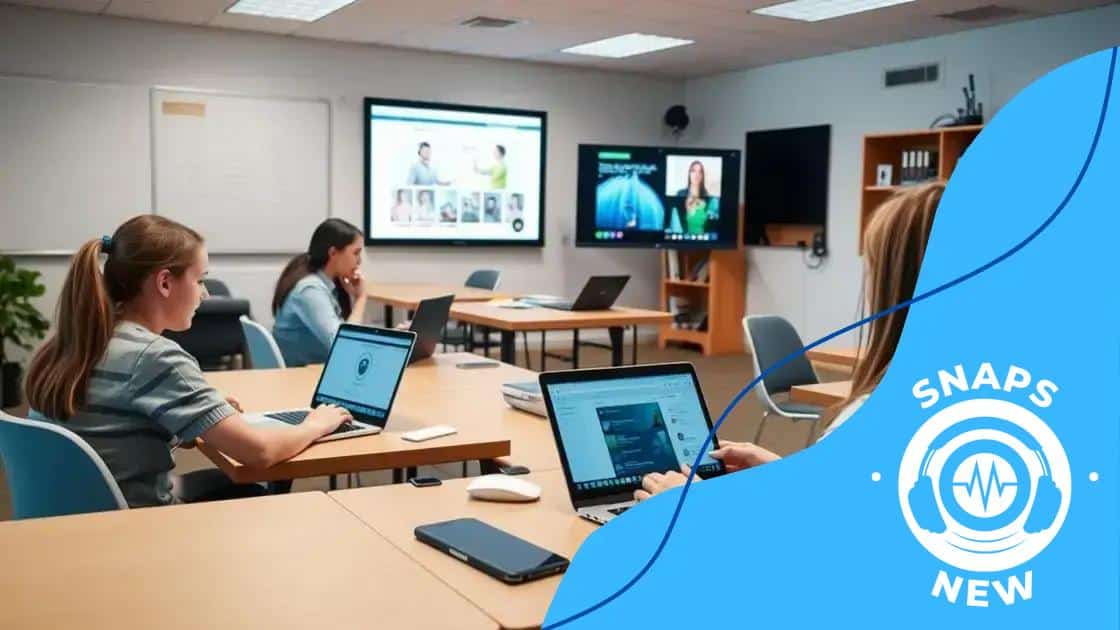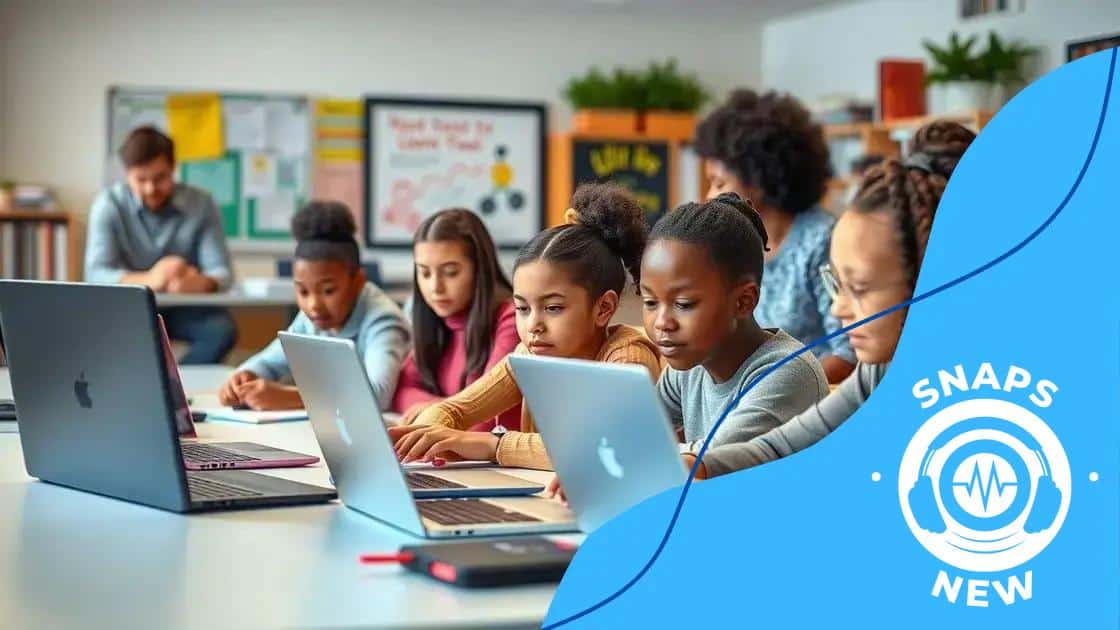Remote learning innovations that are transforming education

Remote learning innovations enhance educational accessibility by utilizing technologies like AI, VR, and interactive platforms, while also addressing challenges such as technology access and social interaction.
Remote learning innovations are reshaping how we think about education. With technology at their core, these innovations open up new possibilities for students and teachers alike. Ready to dive into the future of learning?
The evolution of remote learning
The evolution of remote learning has been remarkable over the past few years, especially with advancements in technology. Schools and universities have adapted to new ways of teaching that make education accessible from anywhere.
The Early Days of Online Learning
Initially, remote learning relied heavily on basic tools like emails and online forums. Students would receive materials and complete assignments without much interaction. As the internet evolved, so did the methods of instruction.
Innovative Technologies Shape Learning
With the introduction of video conferencing tools, virtual classrooms became a reality. This shift allowed for real-time interactions between teachers and students, making the learning experience more engaging.
- Video lectures enhance student engagement.
- Interactive quizzes and polls keep learners involved.
- Collaboration tools foster peer learning.
Moreover, the incorporation of learning management systems (LMS) streamlined administration and communication. These platforms serve as hubs for resources, assignments, and grades, allowing students to monitor their progress closely.
The Growth of Hybrid Learning Models
Today, many educational institutions are embracing hybrid learning models. This approach combines in-person and online classes, giving students flexibility and access to various resources.
- Students can choose between online or face-to-face learning.
- Access to a wider range of courses and materials.
- Opportunities to develop digital skills.
As we look to the future, the ongoing evolution of remote learning promises to enhance educational accessibility, inclusivity, and effectiveness for learners everywhere.
Key technologies driving remote education
Many key technologies are driving the success of remote education, transforming how students learn today. The rise of accessible tech tools has made it easier for educators and learners to connect in a digital world.
Video Conferencing Tools
First, video conferencing tools like Zoom and Microsoft Teams have enabled live interactions between students and teachers. These platforms allow for real-time communication, facilitating discussions and presentations that mimic a traditional classroom.
- Interactive sessions keep students engaged.
- Breakout rooms foster small group discussions.
- Recordings provide flexibility for review.
Moreover, video lectures play a crucial role by allowing students to revisit lessons at their own pace. This flexibility enhances understanding, as learners can pause or replay difficult sections as needed.
Learning Management Systems (LMS)
Another vital technology is the learning management system (LMS). Platforms like Moodle and Canvas help educators organize courses, share resources, and track student progress. An LMS can centralize communication, making it easy for students to access materials and assignments.
- Centralized resources save time for both educators and students.
- Analytics help identify learning trends and challenges.
- Feedback tools enhance student-instructor communication.
These systems help streamline administrative tasks, enabling educators to focus more on teaching and less on logistics.
Interactive Learning Tools
Additionally, the use of interactive learning tools such as Kahoot! and Quizlet makes learning fun and engaging. These platforms facilitate gamified experiences that motivate students to participate actively.
- Quizzes encourage knowledge retention.
- Games foster friendly competition among peers.
- Customizable content allows for tailored learning experiences.
Overall, the integration of these technologies shapes the future of education, creating an enriching environment for learners everywhere.
Benefits for students and educators

The benefits for students and educators in the realm of remote learning are profound and varied. Both groups gain unique advantages that enhance the educational experience.
Flexibility and Convenience
One major benefit is flexibility. Students can learn from any location, allowing them to balance their studies with other commitments. This convenience helps students to engage in their learning without being tied to a specific location.
- Students can learn at their own pace.
- Reduced commute time allows for more dedicated study hours.
- Access to a wider range of learning resources online.
Educators also enjoy flexibility, as they can create lesson plans that suit various learning styles. This adaptability fosters a more personalized approach to teaching.
Increased Engagement
Remote learning often uses innovative tools that boost student engagement. Interactive platforms keep learners active and involved in their lessons, making it easier to participate in discussions and activities.
- Gamified learning experiences can motivate students.
- Immediate feedback helps students understand their progress.
- Group projects encourage collaboration among peers.
For educators, these tools provide opportunities to enhance teaching methods. Engaging materials capture students’ interests, leading to a more vibrant learning atmosphere.
Broader Reach
Remote learning environments can bridge gaps for students who may not have access to traditional educational settings. This can include learners in remote areas or those with disabilities. Similarly, educators can reach a broader audience through online courses and webinars.
Furthermore, this approach allows for a diverse range of subjects and skills to be taught, giving students opportunities that may not exist locally. The ability to learn from experts around the world enriches the educational landscape.
Challenges faced in online learning
While online learning offers many advantages, it also presents several challenges that students and educators must navigate. Understanding these obstacles is essential for improving the remote learning experience.
Technology Access Issues
One of the biggest challenges is access to technology. Not all students have reliable internet or devices capable of supporting online learning. This discrepancy can lead to unequal learning opportunities.
- Many students rely on public Wi-Fi or shared devices.
- Lower-income families may struggle to afford technology.
- Students in rural areas often face connectivity issues.
This barrier can create significant gaps in education, impacting students’ ability to keep up with their peers.
Lack of Social Interaction
Another challenge is the lack of social interaction in online learning settings. Classrooms provide an environment for students to connect with peers, share ideas, and collaborate. In a remote setting, students may feel isolated.
- Limited face-to-face interaction can lead to feelings of loneliness.
- Group discussions may be less engaging online.
- Students can miss out on building relationships with their instructors.
This lack of social presence can hinder learning, as social interactions often enhance understanding and retention of material.
Self-Discipline and Motivation
Online learning requires a higher level of self-discipline and motivation. Students must manage their time effectively to keep pace with assignments and deadlines. For some, this can be a significant hurdle.
Distractions at home can also impede learning. Unlike a classroom, home environments may not provide the quiet and focused atmosphere students need to thrive.
Additionally, setting up a productive learning space can vary greatly among students. Not everyone has access to an ideal study area, which can affect their ability to concentrate and succeed.
Future trends in remote learning
The future trends in remote learning are shaping the educational landscape in exciting ways. As technology continues to advance, the opportunities for effective online education grow.
Increased Use of Artificial Intelligence
One significant trend is the incorporation of artificial intelligence (AI) in education. AI can personalize learning experiences, adapting lessons to meet individual needs. Programs can analyze student performance and suggest resources to help them improve.
- AI tutors can provide additional support outside of class.
- Learning analytics can help teachers understand how students are progressing.
- Adaptive learning platforms offer customized paths for each learner.
This technology not only enhances the student experience but also makes teaching more efficient.
Enhanced Virtual Reality Experiences
Another trend is the use of virtual reality (VR) in remote learning. VR allows students to immerse themselves in different environments, making learning more engaging and hands-on. For example, students can explore historical sites or conduct science experiments in a safe, virtual space.
- Virtual field trips make geography and history lessons come alive.
- Science simulations allow for practical experiments without risks.
- Immersive language learning enables real-life conversational practice.
This type of learning can increase retention and interest, as students interact with content in dynamic ways.
Focus on Social-Emotional Learning
As education evolves, there is a growing emphasis on social-emotional learning (SEL). Educators are recognizing the importance of addressing students’ emotional well-being as part of the learning process. Remote learning platforms are beginning to integrate SEL resources to support students’ mental health.
This focus helps students develop important life skills such as resilience, empathy, and communication. By promoting a balanced approach to education, programs can better prepare students for success in all areas of life.
FAQ – Frequently Asked Questions about Remote Learning
What is the biggest benefit of remote learning?
The biggest benefit is flexibility; students can learn from anywhere, allowing them to balance their studies with other commitments.
How does technology impact remote education?
Technology enhances remote education by providing tools like video conferencing, which enables real-time interaction between teachers and students.
What challenges do students face in online learning?
Students may struggle with access to technology, lack of social interaction, and the need for self-discipline to stay engaged.
What future trends can we expect in remote education?
Future trends include the use of artificial intelligence for personalized learning, virtual reality for immersive experiences, and a greater focus on social-emotional learning.





